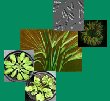| Rehder, H; Beck, E; Kokwaro, JO: The afroalpine plant communities of Mt. Kenya (Kenya): Comment of the vegetation map of Mt. Kenya, Phytocoenologia, 17, 287-288 (1989), doi:10.1127/phyto/17/1989/287 | |
| Abstract: For technical reasons it was not possible to attach the Vegetation Map of. Mt. Kenya (Kenya), 1: 25000, to the corresponding article in Vol. 16 (p. 443-463) of Phytocoenologia. Since it is provided with the present issue an extended abstract of our original article appeared to be desirable. The plant communities of the alpine and nival zones of Mt. Kenya, i.e. the vegetation above timberline of the montane Hagenia-Hypericum rain forest (not differentiated in the map) were investigated by quantitative analysis of the species pattern of about 150 typical plots composed of some 100 species of flowering plants. Mosses were not identified. The analyses were arranged to yield 16 plant communities which, in turn, could be arranged to yield 6 representative vegetation types (Ericaceous Bush; Open Moorlands; Upper Wetlands; Dendrosenecio Woodlands; Upper Tussocks and Dwarf Shrubs; Scattered Vegetation) encountered in the two afroalpine vegetation zones. In the lower afroalpine zone (commonly known as "moorland") and immediately adjacent to the timberline of the Hagenia-Hypericum montane forest (A), Ericaceous bush as well as pure tussock moorland vegetation were recorded each of which, in accordance with soil moisture is dominating wide areas or was found to interdigitate closely with the other. The main plant community of this zone is the Philippia-Pure Moorland-Community (C). The upper region of the lower alpine zone is a domaine of the Dendrosenecio brassica-Moorland-Community (J) which contains two conspicuous giant-rosette plants, namely Dendrosenecio brassica (cabbage groundsel) and Lobelia keniensis. The most important communities of the upper afroalpine zone are the Dendrosenecio brassica-Lobelia keniensis-Community (K) as a representative of the upper wetland and the Lobelia telekii-Dendrosenecio keniodendron-Community (O), well-known as the Dendrosenecio woodland which generally covers the steeper part of the slopes of the valley walls. In contrast to the literature, this community was not subdivided with respect to its field layers because the latter were understood as to result from a cyclic sequence of Alchemilla argyrophylla and Festuca pilgeri, respectively, each of which is capable of producing more or less closed and monotonous field layers. The Festuca pilgeri-Alchemilla argyrophylla-Community (P) was established as another important community of the upper alpine zone, representing the vegetation type 'Upper Tussocks and Dwarf Shrubs' which is characteristic of the upper boundary of the alpine belt. In the nival zone the vegetation peters out and genuine plant communities are difficult to abstract. The most widespread one is dominated by the herbaceous Senecio keniophytum, Festuca abyssinica and Alchemilla argyrophylla. Solifluction rather than frost itself or deficiency of moisture appears as the most serious environmental factor limiting higher plant life in the nival zone of Mt. Kenya. The plant communities, by inspecting the whole area represented by the map 'Mt. Kenya, 1: 25000', were localized and their distribution was transferred to the blueprint of that map. The authors acknowledge printing of the map by the Survey of Kenya. |

Letzte Änderung 30.06.2020

